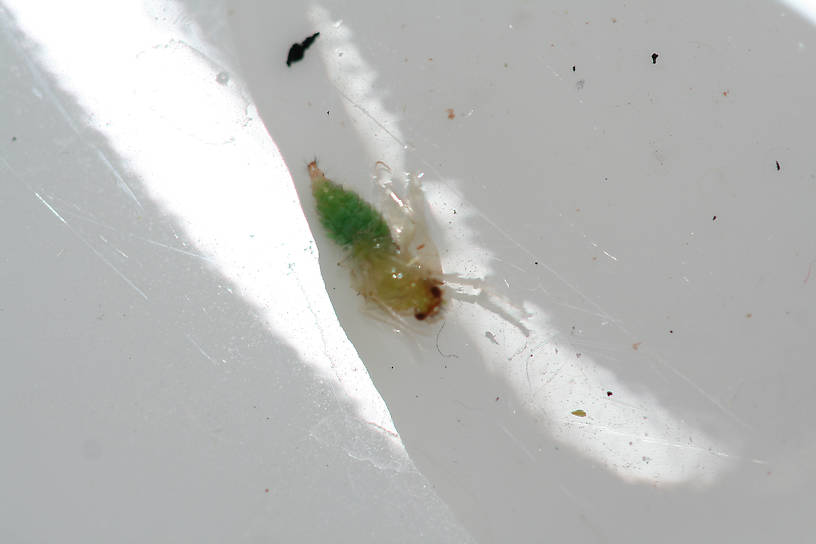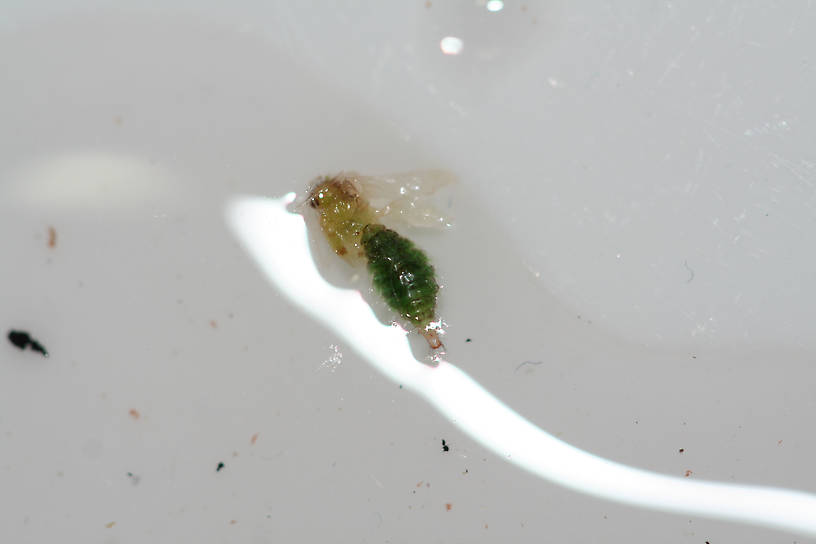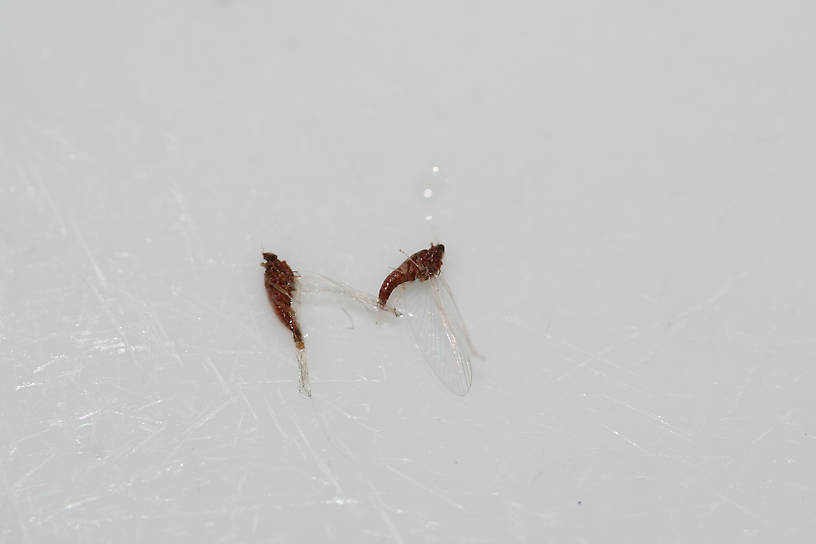Blog & Latest Updates
Fly Fishing Articles
Insects by Common Name


> > A few caddis and a baetid, Page 3
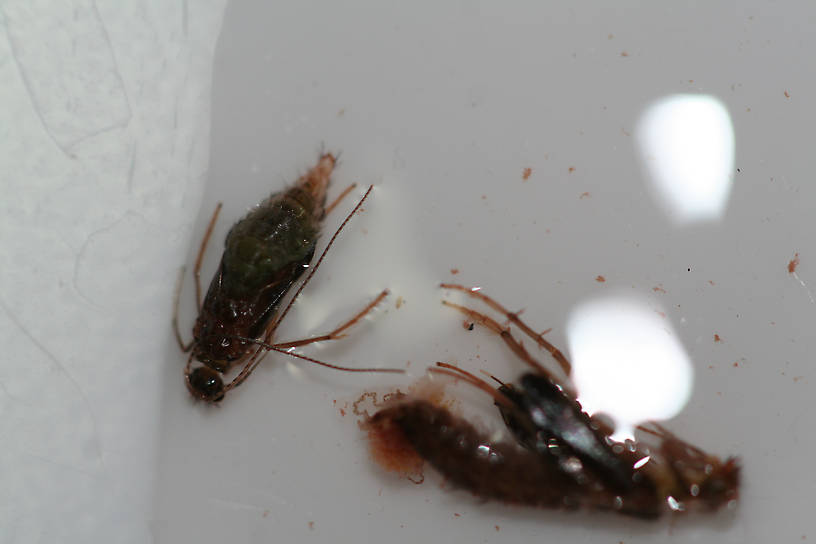
The smaller, more in-focus pupa was still alive, kicking and swimming, hours later while taking photos. The larger, blurry one died pretty quickly - I think I injured it. Size 16 and 12, respectively, nearly identical in color.
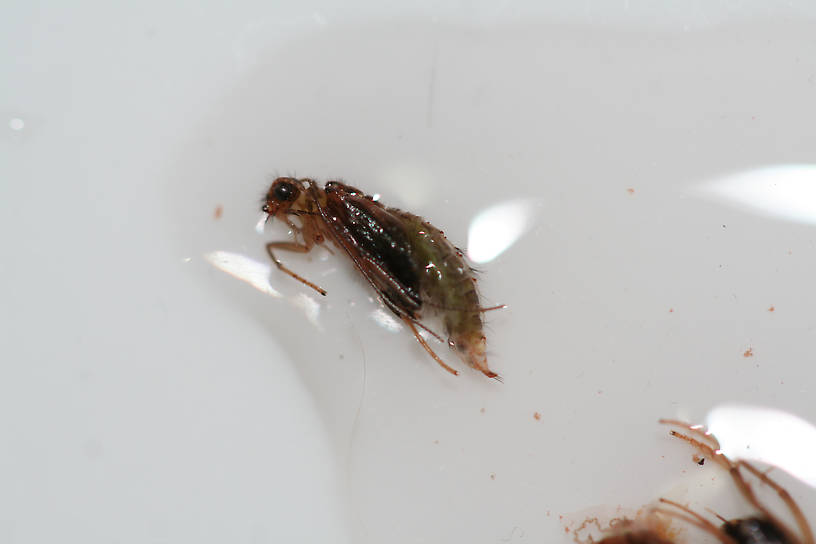
Side view of the smaller one. It didn't like to be flipped over - prefers right-side-up.
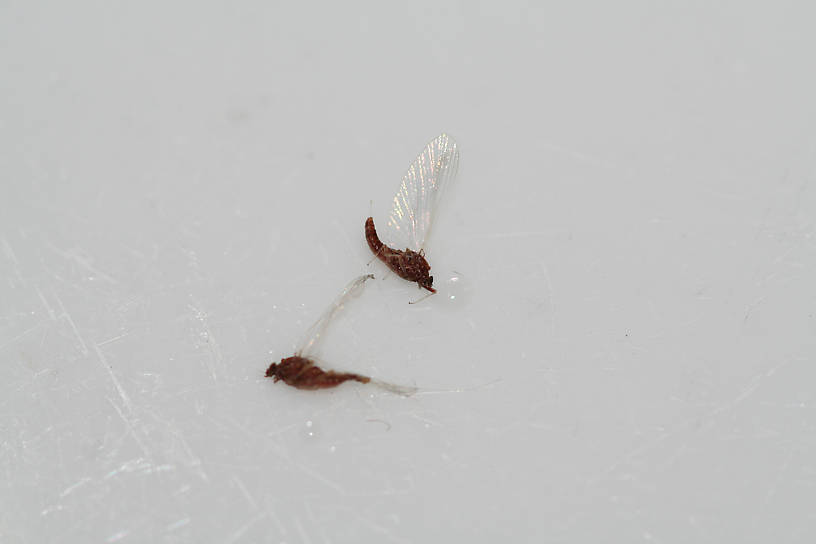
A few more of these little rusty baetids I've been finding. Don't know if the fish have been feeding on them - have only found them here and there. I tied up a few good-looking dries for them, but I haven't fished them yet. Size 24.
| Creno | August 1st, 2012, 10:28 pm | |
| Grants Pass, OR Posts: 305 | Gonzo - good stuff. An hour ago while sorting some Mexican larval collections I ran into a very nice pupal case with a well well preserved pupae. I am going to try and attach a couple quick pics. creno | |
| Creno | August 1st, 2012, 11:13 pm | |
| Grants Pass, OR Posts: 305 | Folks - here is a try at attaching a couple images of a pharate adult separated from the pupal cuticle.  if they don't show up I messed up. | |
| GONZO | August 1st, 2012, 11:39 pm | |
Site Editor "Bear Swamp," PAPosts: 1681 | Bummer! Perhaps someone who is more familiar than I am with the photo-posting process (which in my case is not at all) can post instructions while you're off collecting. PS--See thread entitled "Pupal exuvia pics" for the photos Creno mentions above. PPS--Well, it's well past my "bedtime," and I've gone from loose conjecture about one way the fluid vs. gas debate might be resolved, to a very complex (but fascinating) technical paper describing an example of that possibility in one insect, to (at last) an excerpt from a U. of Utah Bio lecture on "Insect Development I: General Aspects and the Molting Cycle" (my emphasis added in bold): The Molting Cycle It would seem there's much to recommend attending a basic course in insect development. :) | |
| PaulRoberts | August 2nd, 2012, 10:34 am | |
| Colorado Posts: 1776 | There is certainly space in Creno's images for a fluid or gas. Thanks for posting those, Creno. But the question remains, does the pharate adult in moving water habitats swim, buoy, or both to the surface? Do they glisten and shine like an air bubble? I've had "mature" ready to pop Hydropsyche pupae submerged in a dish, and watched them pop and fly off. And they did not glisten, nor float. I did however notice that the midge pharates taken from a trout's stomach floated irrepressibly, while all the other critters in that eclectic sample, were at the bottom of the dish. No light reflecting "bubbles" can be seen under the pharates cuticle. I guess I'm questioning Gary Lafontaine's observations of pharate (I believe Hydropsychids) of glowing reflective pharates. | |
| GONZO | August 2nd, 2012, 11:02 am | |
Site Editor "Bear Swamp," PAPosts: 1681 | But the question remains, does the pharate adult in moving water habitats swim, buoy, or both to the surface? Do they glisten and shine like an air bubble? Yeah...don't know, Paul, but I suspect that the answer to either question might vary a bit. I doubt that gas within a cuticle would be as bright as an external bubble, and the situation and lighting could make it more or less conspicuous. (I've speculated before that in a bubble-rich situation, it might even be somewhat inconspicuous, and the swimming action and/or color of the bug might be more significant traits in that situation.) As for LaFontaine's patterns, I don't know any fly-fisher folk who doubt their effectiveness (but I'm sure there are a few). As I recall, he may have mentioned that the "sparkle pupa" patterns represented the nexus of his theories of imitation and attraction, so the brightness may simply be an exaggerated trait. At any rate, it would seem plausible that his air bubble "theory" might not be just another angling myth. But we still have plenty of angling myths to go around, so the potential loss of one is no big deal. :) | |
| Martinlf | August 2nd, 2012, 11:37 am | |
Moderator Palmyra PAPosts: 3233 | Wow, I just saw this thread after posting my comment on LaFontaine patterns. Great information here. | |
| "He spread them a yard and a half. 'And every one that got away is this big.'" --Fred Chappell | ||
| PaulRoberts | August 2nd, 2012, 12:45 pm | |
| Colorado Posts: 1776 | Gary described bright shiny bubbles. One would think SOMEONE, observing pupae in hand or while wading, or cleaning trout stomachs, would see this. Nary a peep. It seems it's simply passed on as some "scientific fact", when I see it as a "possiblility" at best. As to the effectiveness of such flies I like GONZO's suggestion of an an "exaggerated trait". However, lots of flies work and likely often for threads of reason (or none at all) other than what we are thinking. Also, diving adults DO shine as Gary describes. I've seen that, and imitated it with tremendous result. | |
| Entoman | August 2nd, 2012, 2:30 pm | |
| Northern CA & ID Posts: 2604 | Thanks for sharing the photos, Creno. If you click on the "full view size" button of Shawn's second photo, you can make out the separation as well, but it shows up much better in yours. Gonzo, that's great info dealing with the process occurring terrestrially. It seems to me that for ecdysis to occur there, it would be advantageous for the fluid to be replaced by air allowing the cuticle to dry and be shed more easily. Perhaps this process is very similar to the one used by some of the large lake dwelling caddis that scoot across the surface to shed the pupal cuticle from bankside structures? Same with stoneflies and mays like Isonychia. When this process takes place in an aquatic environment though, the drying out of the cuticle and replacing the molting fluid with air seems problematic. There is also surface tension utilized for assistance to factor as a difference between the two as well. Though the possibility of self generated gases remains open I suppose, I'm pretty sure there are some different factors in the process going on. | |
| "It's not that I find fishing so important, it's just that I find all other endeavors of Man equally unimportant... And not nearly as much fun!" Robert Traver, Anatomy of a Fisherman | ||
| GONZO | August 3rd, 2012, 8:00 am | |
Site Editor "Bear Swamp," PAPosts: 1681 | Paul and Kurt, I think we are dealing with two very different questions here: a concrete one (about what fills the space between the old cuticle and the ready-to-emerge adult in caddisflies) and another one about whether Gary LaFontaine's fly-theory observations/rationale are accurate. I suspect this second question will remain a basis for broad speculation--motivated by personal belief on all sides. In contrast, the first question has an answer, even if no one (currently) on this thread knows that answer. It does seem, however, that the process of replacing the molting fluid with a gas is the norm in insect molts. If you don't believe that happens with caddisflies, fine, but here's what I find "problematic" about that speculation: From what I can gather, resorbing the molting fluid serves some important functions in the process of molting in most (all?) insects, including the "recycling" of proteins and other products produced when the endocuticle is broken down and perhaps facilitating the insect's successful escape from the old cuticle. Assuming (as the Bestman and Booker paper states) that resorption of the molting fluid is common to all insect molts, then what fills the space between the old and new cuticle in emerging caddisflies if not a gas? I'm not suggesting that it can't be something else--obviously, I just don't know. But if the idea is that it is still molting fluid at that stage in the process, that seems (to me) to be an attempt to replace one presumed "myth" with another. | |
| Shawnny3 | August 3rd, 2012, 9:21 am | |
Moderator Pleasant Gap, PAPosts: 1197 | Perhaps I'm missing something here, but how can we assume that the method of gas injection used by terrestrial insects is used by aquatic insects? It's easy to see how a terrestrial insect could acquire air to pump into a space, but where would an aquatic insect get the air in the first place? The insect below the water's surface would either need to use oxygen extracted from the water via its gills or manufacture its own gas internally for that purpose. Perhaps I'm missing something - I've been reading over the posts here pretty quickly - but I am wondering how the aquatic insects gets the air in the first place. Or have people been using the term air interchangeably with the word gas? If the terrestrial insect really does pump air between the old and new (the exuvial space is what you guys have been calling it, I think), then it seems likely to me that an aquatic insect would have a different mechanism as it pertains to the gas, or lack thereof. -Shawn | |
| Jewelry-Quality Artistic Salmon Flies, by Shawn Davis www.davisflydesigns.com | ||
| GONZO | August 3rd, 2012, 9:42 am | |
Site Editor "Bear Swamp," PAPosts: 1681 | Or have people been using the term air interchangeably with the word gas? Yes, and although there is a distinction (one is a subset of the other), that distinction does not always seem to be made even in the scientific literature. My concern has been to share what I could find in an attempt to address the "gas vs. fluid" issue (which was the original question posed by Paul). If the quibble is simply about the distinction between gas and air, I agree that there (obviously) is a difference. However, if it's obvious where an air-breather would get the air, I don't see why it is not just as obvious where a gas-breather would get the gas. :) | |
| PaulRoberts | August 3rd, 2012, 9:58 am | |
| Colorado Posts: 1776 | I had the same question as Shawn. It's easy to see where a moth gets air/gas. It can be drawn in from outside. A caddis must produce it. Thus a structure would exist in pharate caddis to do this -a rete mirabile of some sort? Do they possess such an apparatus? Yes -the gills. However, these were shed during transformation. Yes? But they must remain functional long enough to see teh insect through the transformation process. But, the pharate has to have a way gaining O2 as a pharate too. Maybe a rete-type structure does exist, or the last moments of gill function pump O2 in, which acts as a diving bell to see them to the top -to breath and buoy them too. Adult divers are covered with hairs which trap air, I assumed to take O2 with them when they dive. Just some thoughts. | |
| GONZO | August 3rd, 2012, 10:16 am | |
Site Editor "Bear Swamp," PAPosts: 1681 | Yes, Paul, the exact mechanism involved is uncertain (at least to me) and at the heart of the question. If the space between the old and new cuticle is filled with fluid, I imagine it would only be (internally) stored oxygen that would see the adult through the process leading up to emergence, and I don't deny that might be possible. (And that might be the way it works even if the space were filled with gas--CO2 for example.) I'm still wondering what else could fill that space if it is not gas. Water perhaps? That seems to present some issues as well, but without knowing the process by which molting fluid is exchanged for something else, I can only add that the main thrust of the Bestman and Booker paper that I cited was to establish that (in their example) the foregut was involved in the removal of molting fluid. PS--FWIW, I thought I'd add an interesting (to me) side note to Paul's comments about bugs that carry a bubble of air with them underwater. That bubble is sometimes described as an "artificial gill." Apparently, from what I have read, not only does it provide an oxygen supply in the form of air, but it also extracts oxygen from the water. Until I read this description of the process, I had always assumed that that it was just a matter of exhausting the oxygen originally contained in the bubble. | |
| PaulRoberts | August 3rd, 2012, 2:02 pm | |
| Colorado Posts: 1776 | I think what's involved with the "bubble acting as gill" is simply diffusion from a higher to lower conc. It's efficiency is low thus requiring exchange. Maybe this can happen through the pupal skin? Or, does the pupa have functional gills bringing O2 in? Or...if the adults spiracules are functional then maybe they are using a "bubble gill"? This (how the pupa gets O2) is a pretty basic anatomical question that MUST have been looked into. | |
| Entoman | August 3rd, 2012, 2:28 pm | |
| Northern CA & ID Posts: 2604 | Perhaps the answer is a bit of both? Another factor that hasn't been discussed is the effect of pressure. A gas contained under the cuticle will exert different forces at different depths whereas a liquid will remain neutral. Maybe a little bit of gas builds up over the thoracic notum assisting in the "split" that occurs as the ecclosion process starts? Gas would contribute expanding forces as the pharate reaches the surface.I'm don't see why it is not just as obvious where a gas-breather would get the gas. :) Good point, Lloyd. The animal still exchanges metabolic gases regardless of its environment and these gases have to go somewhere. However, couldn't they be in homogeneous solution with the molting fluid and released through the cuticle? To me, it seems use of the word "air" suggests a difference from gases engaged in the metabolic process. Biologists are usually pretty precise in their use of language. Perhaps the outer cuticle is permeable by some process either through cracks or fissures or perhaps enzymatic action? To me it makes sense that "air" would replace the absorbed molting fluid in this fashion during a terrestrial ecclosion, otherwise the animal would either be born wet or the vacuum created would "shrink wrap" the critter, also putting a serious "damper" on the process.:) As to aquatic emerging caddis having subcutaceous gas as opposed to liquid, the necessity for the molting fluid to be replaced assumes that the molting fluid is mostly absorbed. If it is, then the next assumption would be that metabolic gases replace it without being in solution, as it can't possibly be "air". All possible of course, though it must be admitted that a lot of astute anglers haven't found evidence of this. Perhaps that's because gas under a cuticle looks entirely different from gas bubbles encased in water pressure, the former being more translucent and less mirror like? Regardless, there is no doubt in my mind that the "shiny bubble" pupa is in the "angler myth" category. Perhaps the "shiny bubbles" LaFontaine observed were egg-laying adults mixed in with an emergence (which happens all the time)? As to the effectiveness of antron used on imitations, I believe it is because the material takes on a translucent "glow" when submerged that makes it so effective. I've long since gotten away from the round bubble look, employing it either as a sparse collar or a tighter sheath than LaFontaine employed and only over the back. FWIW - This topic brings to mind the possible explanation for another phenomenon. Deep water midges don't emerge straight up, they stage much like scuba divers do on their ascent. Perhaps they are dealing with gases and pressure for the same reasons? Clouds of them can be found in say 10 feet of water for quite some time and trout swim back and forth through them like whales feeding on shrimp! | |
| "It's not that I find fishing so important, it's just that I find all other endeavors of Man equally unimportant... And not nearly as much fun!" Robert Traver, Anatomy of a Fisherman | ||
| PaulRoberts | August 3rd, 2012, 3:23 pm | |
| Colorado Posts: 1776 | Yes, midges and various crustaceans, can adjust their buoyancy to change depths. Gas? Lipids/oils? | |
| GONZO | August 3rd, 2012, 6:48 pm | |
Site Editor "Bear Swamp," PAPosts: 1681 | Regardless, there is no doubt in my mind that the "shiny bubble" pupa is in the "angler myth" category. Yeah, it could be, Kurt, but the case for blaming Gary LaFontaine for that myth is overstated, IMO. I don't mean to sound like an apologist for Gary, because I've questioned some aspects of this myself in previous threads, but the poor guy is dead and can't speak for himself. The question of whether the emerging insect has gas in the exuvial space is one thing, and if that part is incorrect, it would seem that Gary was incorrect about his statements and/or observations and may have been selling all of us a bill of goods. Shame on him if that was the case, but I think the jury's still out on that. However, it is also unfair to hold him responsible for the way we interpret or remember what he said, especially if we have created a "false memory." The "shiny bubble pupa" or "quicksilver pupa" expressions (found in this thread and the earlier related topic "Caddis Pupae Question") are your own words. When I look at what Gary actually said, "shimmer" and "sparkle" are the words he used most often in his description of the "pupa" on page 34. He describes it as a "splotchy combination of color and reflection" elsewhere (pg. 62). You have used "translucent glow" and "sheathed glistened look" as descriptions of what you see. Perhaps there is a slight difference depending on how you interpret those words, but it doesn't seem like it's worth fussing about. Gary never used the word "quicksilver" in describing the pupa. It does appear in a quotation from Sid Gordon on page 61...describing the diving adult. | |
| PaulRoberts | August 3rd, 2012, 6:55 pm | |
| Colorado Posts: 1776 | Thanks, GONZO. That's a worthwhile clarification. I've been meaning to look into exactly how Gary described pupae. | |
| GONZO | August 3rd, 2012, 7:10 pm | |
Site Editor "Bear Swamp," PAPosts: 1681 | No problem, Paul. Just so whatever blame or credit is deserved for this notion is appropriately shared, I'll also point out that Ernie Schwiebert said this in Nymphs (8 years before LaFontaine's Caddisflies): Ribbing a hatching pupa with fine oval tinsel--gold with brown fur dubbing and silver with gray--to simulate the tiny bubbles of gas entrapped inside the splitting pupal shuck is a useful refinement on selective fish.If Gary was wrong, perhaps Ernie deserves some of the blame for giving him the idea. But they're both in the grave and should probably be forgiven for whatever contributions to the "myth" they may have made. :) Another factor that hasn't been discussed is the effect of pressure. A gas contained under the cuticle will exert different forces at different depths whereas a liquid will remain neutral.Yeah, even if both terrestrial and aquatic insects fill the sheath with gas, Kurt, that would certainly be a difference for aquatic insects. Way back when I used to do a lot of scuba diving with friends, we would often entertain ourselves by blowing air rings (similar to the way you to blow smoke rings). We'd settle on our backs at the bottom of a swimming pool or pond, and the trick was to try to blow a perfect ring so it would hold together as it rose to the surface. The ring would be huge when it popped to the surface. | |
| Martinlf | August 4th, 2012, 9:59 am | |
Moderator Palmyra PAPosts: 3233 | OK, I'm again going to venture into this very technical discussion to clarify what I meant in an earlier post. From the photos Creno posted it is clear that at some point the lighter shuck can be seen as separate from the darker adult body within, and I'd guess that as the shuck splits it could fill further with water, creating an even larger veil around the hatching adult. This MAY help explain the demonstrated effectiveness of the LaFontaine caddis, though other factors linked either to attraction or imitation are also very likely at work. Gary may have been wrong about the exact mechanism, but his observations and resulting fly patterns have resulted in many hooked fish. | |
| "He spread them a yard and a half. 'And every one that got away is this big.'" --Fred Chappell | ||
Quick Reply
You have to be logged in to post on the forum. It's this easy:
Related Discussions
| Title | Replies | Last Reply |
| Re: Hydropsychid? In Hydropsyche Caddisfly Pupa by GONZO | 14 | May 7, 2009 by LittleJ |
| Re: Live Chimarra pupae In the Identify This! Board by Millcreek | 13 | Oct 2, 2014 by Millcreek |
| Re: Caddis Pupae Question In the Insect Order Trichoptera by PaulRoberts | 40 | Nov 23, 2015 by Martinlf |
| Re: caddis pupa In General Discussion by LittleJ | 3 | May 16, 2010 by Creno |
| Re: Pupal exuvia pics In the Photography Board by Creno | 7 | Aug 5, 2012 by PaulRoberts |
| Several new specimens In General Discussion by Troutnut | 0 | |
| Re: Pupa color? In the Caddisfly Genus Chimarra by Frankcoz | 6 | Apr 5, 2012 by Entoman |
| Re: La Fontaine Caddis patterns In General Discussion by Goose | 3 | Oct 19, 2006 by GONZO |
| Re: another caddis question In General Discussion by Goose | 12 | Oct 21, 2006 by GONZO |
| Green Sedge In the Identify This! Board by Wiflyfisher | 0 |
Troutnut.com is copyright © 2004-2024 Jason
Neuswanger (email Jason). See my FAQ for information about use of my images.
 privacy policy
privacy policy

